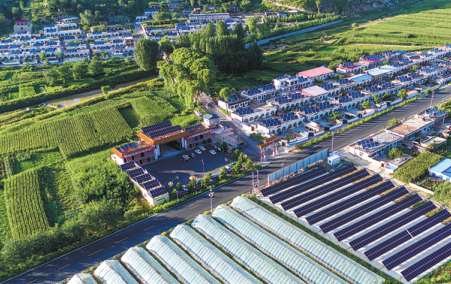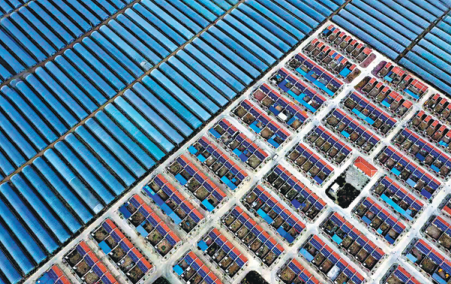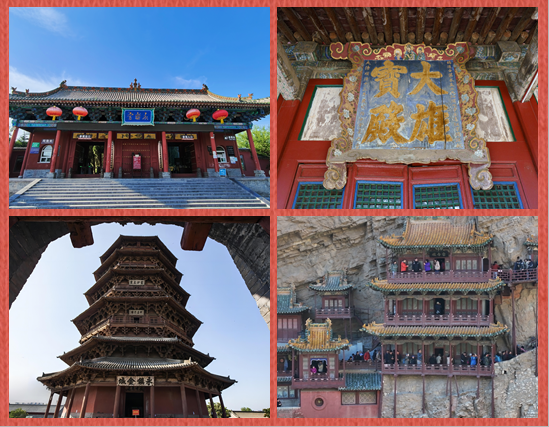Solar power brightens rural Shanxi livelihoods
Updated: 2021-04-23

The solar farm in Xinyi township, Lishi district, in the city of Lyuliang includes photovoltaic panels installed on the roofs of farmhouses that can meet local demand and supply electricity to the rest of Shanxi province. [Photo by Liu Liangliang for China Daily]
Electricity generation projects using green technology create jobs and incomes for once-poor villagers
Wu Qiang, a villager of Erji in Daning county, North China's Shanxi province, said "making a fortune from sunlight" used to sound like a story from Arabian Nights.
However, he now works patrolling a solar farm near his home and does believe sunlight can generate money.
The solar farm, owned and operated by the village, consists of about 400 photovoltaic panels on 0.2 hectares of land. Electricity generated from the panels is connected to a nearby substation and then transmitted to a power grid that supplies electricity to the province.
In addition to the stable monthly salary from the solar farm, Wu said he, as well as his fellow villagers, receives annual dividends.
"All the villagers are stakeholders of the solar farm," Wu said. "We are getting more dividends as the solar farm's profits increase year-by-year."
Erji used to be a village that relied upon farming infertile lands.
To help to lift villagers out of poverty, the county government of Daning and the city government of Linfen-which has Daning in its jurisdiction-signed an agreement with State Grid in 2013 to launch a solar farm in Erji.
With a power generation capacity of 100 kilowatts, the solar farm began construction at the end of that year.
The project was completed and began operating in July 2014. It was the first village-operated solar farm and power station in China.
Construction of a second solar farm and power station, with a capacity of 300 kW, began in 2018.
"The operation of the first solar power station brought an average annual net income of 300,000 yuan ($46,000) to the village," said Xu Yusheng, Party secretary of the village. "The income has played a crucial role in reducing poverty in Erji."
In addition to offering dividends to villagers, the solar farm and power station has offered jobs.
"The jobs, including safety guards, cleaners and maintenance workers, were mostly created for the low-income families," Xu said.
Ma Yue'en, a villager in his 80s, is one of the beneficiaries. In addition to dividends, Ma receives an elderly subsidy and another for buying fertilizer from the village committee.
"All the subsidies come from the revenues of the solar farm," Ma said.
Feng Guoning, a worker at the solar power station, said his top concern is the weather every day.
"Sunlight means electricity and revenue," Feng said. "The power station is just like a treasure chest, offering continuous support for poverty alleviation."

Residents in Zhonghe village in Yanggao county can get a per capita revenue of 260 yuan ($40) from the village's solar panels. [Photo by Liu Tong for China Daily]
In Linxian county in the city of Lyuliang, there are a number of solar farms and power stations of a much larger scale.
In the county's Baiwen township, for instance, there is a solar farm covering more than 80 hectares.
A poverty-alleviation project, the solar farm can generate 44 million kilowatt-hours of electricity.
According to Gao Zerong, an official of the Linxian committee of the Communist Party of China, the large solar farm and power station is owned and operated by six villages. They all used to be on the county's least-developed villages list.
"We have solar power facilities in all the 53 least-developed villages in Linxian," Gao said. "A total of 4,997 low-income families have benefited from such facilities, as these offer dividends, rent and jobs to the residents."
In Zezhou county in Jincheng city, there are six village-owned and four township-owned poverty-alleviation solar farms, which benefit 1,042 low-income families across 68 villages.
Li Jinguo, an official of the county's energy bureau, said the solar power projects bring multiple benefits to residents.
"These projects create a stable source of revenue for low-income families for at least 20 years," Li said. "They also greatly benefit the environment because of their zero emissions."
Located at the east of the Loess Plateau, Shanxi is one of the most favorable locations in China to develop solar power stations because of its access to abundant sunlight.
In 2014, the province was selected by the State Council's poverty reduction office and the National Energy Administration as the country's first pilot province in launching a photovoltaic industry targeting poverty alleviation, according to Zhang Linyang, an official at the Shanxi Poverty Alleviation Office.
"With the strong support from central authorities, Shanxi has witnessed rapid growth in the photovoltaic industry in impoverished areas," Zhang said.
According to the official, the least-developed counties and villages have been prioritized in the development of solar-power facilities.
"About 43 percent of the poverty alleviation solar power stations have been built in Shanxi's 10 least-developed counties," Zhang said. "All the 58 counties that used to be on Shanxi's and China's poverty list now have poverty-reduction solar power stations."
To date, Shanxi has a total of 5,479 poverty-alleviation solar power stations owned and operated by villages. Their installed power generation capacity totals 2.94 million kW. Net income from these projects amounted to 1.96 billion yuan in 2020, according to Zhang.
Li Shu contributed to this story.



